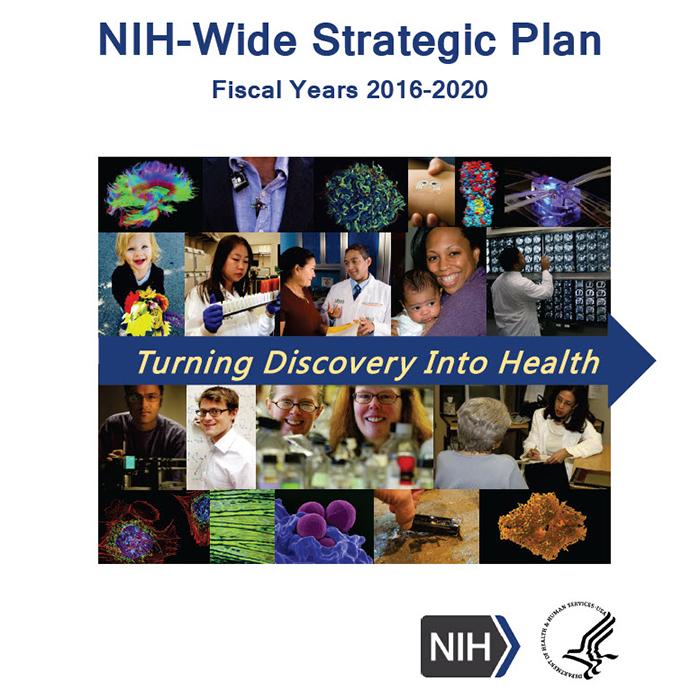NIH-Wide Strategic Plan — Fiscal Years 2016–2020
NIH-Wide Strategic Plan — Fiscal Years 2016–2020
About the Strategic Plan
In order to advance its mission and fulfill a request from Congress, NIH developed the NIH-Wide Strategic Plan, Fiscal Years 2016–2020: Turning Discovery Into Health. This plan outlines a vision for biomedical research to capitalize on new opportunities for scientific exploration and address new challenges for human health. Developed with input from hundreds of stakeholders and scientific advisers, and in collaboration with leadership and staff of NIH’s Institutes, Centers, and Offices, the plan is designed to complement the ICOs’ individual strategic plans, which are aligned with their congressionally mandated missions.
Planning
In 2015, NIH created a working group to develop a framework outlining the direction of the NIH-Wide Strategic Plan. This working group, which was composed of representatives from NIH Institutes, Centers, and Offices within the Office of the Director, was led by NIH Principal Deputy Director Lawrence A. Tabak, D.D.S., Ph.D. To gather feedback from the community on the direction of the plan, the working group coordinated numerous outreach activities:
- Three webinars were held in August 2015 and drew nearly 750 participants.
- A Request for Information (RFI) on a framework for the NIH-Wide Strategic Plan solicited over 450 responses. NIH conducted an analysis of the input on the RFI and published a report.
- Discussions with more than 20 National Advisory Councils, including the Advisory Committee to the NIH Director, were held in the fall of 2015.
The framework below, which informed the development of the NIH-Wide Strategic Plan, identifies areas of opportunity that apply across biomedicine and unifying principles to guide NIH in supporting the biomedical research enterprise.




Frequently Asked Questions
1991–1992.
The NIH-Wide Strategic Plan Fiscal Year 2016–2020 places NIH’s enduring mission in the context of tomorrow’s challenges and opportunities. Working with our many partners in the public and private sectors, NIH will use the plan as we strive to turn scientific discoveries into better health, while upholding our responsibility to be wise stewards of the resources provided to us by the American people. The plan is also designed to harmonize decision making across the Agency.
Progress in achieving the goals will reveal where optimal changes can be made in the future or what additional opportunities are emerging.
Yes, this strategic plan is meant to be a living document that will require refinement throughout its lifecycle.
In addition to continual modifications, the strategic plan will be reviewed and updated every 5 years.
As Congress contemplated increases in NIH funding, they asked for a clear articulation of NIH research priorities, how they were chosen, and what processes are in place to ensure sound stewardship of the public's investment in biomedical and behavioral research. Congress included a mandate for NIH to develop an agency-wide strategic plan in the FY2015 Appropriations Bill (HR 83).
Yes.
The NIH, which is composed of 27 Institutes and Centers (ICs), has not previously had an agency-wide strategic plan. However, the NIH Institutes and Centers have strategic plans addressing their individual missions, and there also are several strategic plans focused on specific research areas, such as women’s health, obesity, and health disparities.
Numerous discussions with NIH leadership, staff, the Advisory Committee to the Director, NIH IC Advisory Councils, and external stakeholders were held to determine the key topics to be included and addressed in the NIH-Wide Strategic Plan. Following consideration of this feedback, the plan was designed to highlight the crosscutting nature of the NIH Institutes, Centers, and Offices to optimize our processes to enhance our stewardship, and identify major trans-NIH themes.
This page last reviewed on



